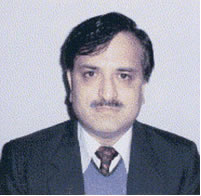Total arterial revascularization in a child with familial homozygous hypercholesterolemia
Anil Bhan, MCha,*, Sunil Swain, MSb, R. Juneja, DMc, P. Saxena, MDc, P. Venugopal, MCha
a Department of Cardiothoracic and Vascular Surgery, All India Institute of Medical Sciences, Ansari Nagar, New Delhi, India
b Department of Cardiology, All India Institute of Medical Sciences, Ansari Nagar, New Delhi, India
c Department of Cardiac Anaesthesia, All India Institute of Medical Sciences, Ansari Nagar, New Delhi, India
 Received for publication January 28, 2004; revisions received March 11, 2004; accepted for publication March 15, 2004.
Received for publication January 28, 2004; revisions received March 11, 2004; accepted for publication March 15, 2004. * Address for reprints: Anil Bhan, MCh, Department of Cardiothoracic and Vascular Surgery, All India Institute of Medical Sciences, Ansari Nagar, New Delhi-11 0029, India (E-mail: bhan@medinst.ernet.in).
Premature coronary artery occlusive disease in familial homozygous hypercholesterolemia might necessitate coronary bypass surgery in children and young adults. Arterial grafts have been shown to be superior to venous grafts in children, with longer patency rates and a better growth potential.1,2 Young adults with familial hypercholesterolemia also fare better with internal thoracic grafts, although the benefit of multiple arterial grafts is still unproved in this setting.3,4 Surgical angioplasty of the main coronary arteries is another alternative to preserve the precious arterial conduits for future reoperations.5 Saphenous venous grafts, although inferior, have also been found to have some growth potential and long-term patency, even up to 22 years.6,7
The subject of this report is a 12-year-old child with familial homozygous hypercholesterolemia and severe obstructive coronary artery disease who underwent a total arterial revascularization. To the best of our knowledge, this is the first report of total arterial revascularization at this age.
Clinical summary
A 12-year-old boy (weight, 22 kg) presented to our cardiac clinic with a history of exertional angina of more than 2 years’ duration. His anginal symptoms had shown recent worsening with frequent rest pains, and at present, he was unable to walk even 100 m without becoming symptomatic. He had a strong family history of hypercholesterolemia, premature coronary artery disease, and death but had no other classic major risk factors. He had multiple tendinous xanthomas over his fingers, elbow . . . [Full Text of this Article]